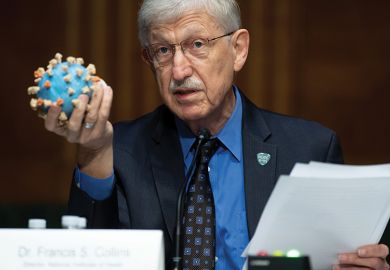The US National Institutes of Health produces some of today’s most cutting-edge science. Yet it seems to have an aversion to one of the modern world’s most ubiquitous and useful communications tools, and that disconnect is beginning to upset its academic partners.
The tool is the internet, and for more than a decade the NIH has largely banned the inclusion of hyperlinks in research grant applications.
The nation’s leading funder of basic research offers two main reasons for its prohibition: one, links allow applications to evade strict page-based limits on the size of grant applications; and two, clicked links could allow applicants to identify their reviewers.
“NIH may withdraw your application from consideration if you include them,” the $45 billion (£37 billion) federal agency recently warned scientists in a blog posting. “Don’t risk it!”
The prohibition has long bothered some scientists, who argue that the stance is badly outdated. Among them is Richard Scheuermann, an adjunct professor of pathology at the University of California, San Diego, and director of the La Jolla campus of the J. Craig Venter Institute, who said he lost an NIH grant over a single inadvertent inclusion of a URL in his application.
By the time he could amend and resubmit his bid, Professor Scheuermann said, the funding opportunity had expired. “And I had no recourse,” he said. “They just said, ‘No, sorry.’”
His San Diego colleague Michael Oldham, an associate professor of neurological surgery, said he understood the basic rationale offered by the NIH. “At the same time, as bioinformatic resources grow ever more complex, it seems inadequate and antiquated to insist that they be evaluated without interaction” with online resources, Dr Oldham said of NIH applications.
The NIH had allowed links in the past, Professor Scheuermann said, and the agency simply told reviewers that reading additional material was not required. That provided a good middle ground, he explained, because there were times when a reviewer might see value in exploring the added detail.
And it is theoretically possible that, as the NIH fears, a grant applicant might try to identify a reviewer who clicked on a link. But there have been no reported cases of such behaviour, and applicants can probably deduce which members of an NIH panel are handling their cases anyway, Professor Scheuermann said.
The NIH declined to discuss the matter, but it said “only a small number of applications are withheld each year due to hyperlinks in the prohibited sections”.
Register to continue
Why register?
- Registration is free and only takes a moment
- Once registered, you can read 3 articles a month
- Sign up for our newsletter
Subscribe
Or subscribe for unlimited access to:
- Unlimited access to news, views, insights & reviews
- Digital editions
- Digital access to THE’s university and college rankings analysis
Already registered or a current subscriber?







